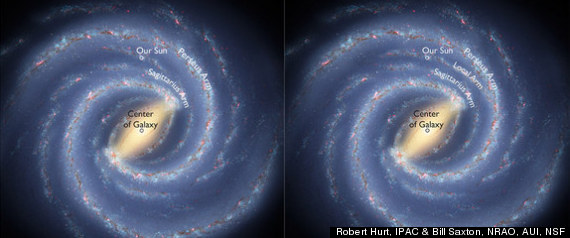Earth's 'Home' In Milky Way Much Bigger Than Previously Thought, Astronomers Say
Message boards :
Science (non-SETI) :
Earth's 'Home' In Milky Way Much Bigger Than Previously Thought, Astronomers Say
Message board moderation
| Author | Message |
|---|---|
 Lynn Lynn Send message Joined: 20 Nov 00 Posts: 14162 Credit: 79,603,650 RAC: 123 
|
Everyone, Earth's 'Home' In Milky Way Much Bigger Than Previously Thought, Astronomers Say  (Left) Old picture: Local Arm a small "spur" of Milky Way. (Right) New picture: Local Arm probable major branch of Perseus Arm.  Trigonometric Parallax method determines distance to star or other object by measuring its slight shift in apparent position as seen from opposite ends of Earth's orbit. The universe wastes nothing, it's simply transferred. Lynn |
 Bob DeWoody Bob DeWoody Send message Joined: 9 May 10 Posts: 3387 Credit: 4,182,900 RAC: 10 
|
I suppose this means there are more stars in the general vicinity that could have candidate planets in the search for habitable worlds. Bob DeWoody My motto: Never do today what you can put off until tomorrow as it may not be required. This no longer applies in light of current events. |
 Lynn Lynn Send message Joined: 20 Nov 00 Posts: 14162 Credit: 79,603,650 RAC: 123 
|
I suppose this means there are more stars in the general vicinity that could have candidate planets in the search for habitable worlds. Prime Galactic Real Estate.. went up with the finding yesterday. Habitable worlds, think there are just a few, doubts we could live on one. Let alone getting there. |
 Bob DeWoody Bob DeWoody Send message Joined: 9 May 10 Posts: 3387 Credit: 4,182,900 RAC: 10 
|
I suppose this means there are more stars in the general vicinity that could have candidate planets in the search for habitable worlds. I totally agree. We aren't going even to the nearest star anytime soon. So I guess the main justification in the search is to eventually find ET. Bob DeWoody My motto: Never do today what you can put off until tomorrow as it may not be required. This no longer applies in light of current events. |

©2024 University of California
SETI@home and Astropulse are funded by grants from the National Science Foundation, NASA, and donations from SETI@home volunteers. AstroPulse is funded in part by the NSF through grant AST-0307956.